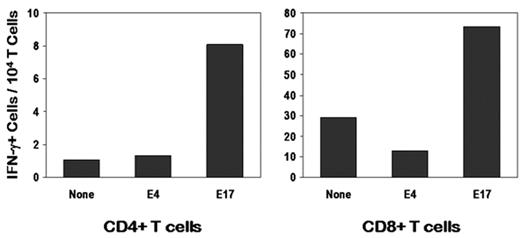Abstract
Human Neutrophil Elastase (HNE) is aberrantly expressed by myeloid leukemia cells and contains the antigenic PR1 peptide sequence inducing HLA-A*0201 restricted cytotoxic T cells (CTL) against leukemic cells. Our previous studies demonstrated that full length HNE protein can induce both CD4+ and CD8+ T cell responses in healthy individuals including HLA- A*0201 negative individuals, indicating an immunogenic potential of HNE beyond the PR1 peptide (Fujiwara H et al Blood 2004). To identify new HNE epitopes, a peptide matrix consisting of 15mers overlapping by 11 amino acids spanning HNE was screened using peripheral blood mononuclear cells (PBMC) from patients with acute myeloid leukemias (AML). Peptide candidates predicted using syfpeithi predictive algorithms were evaluated by measuring responses to candidate epitopes. We found a novel HNE peptide E17 (HNE: 65–80), recognized by both CD4+ and CD8+ T cells in an HLA-A (11, 31) patient with AML. E17 induced significant proliferation of CD4+ T cells 3.2X and CD8+ T cells 4.6X above background, as measured by CFSE flow cytometry-based proliferation assay. E17 induced IFN-g expression in CD4+ T cells 7.4X and in CD8+ T cells 2.5X above background in flow cytometric assay (see figure). E17 (HNE: 65–80) peptide induced IFN-g mRNA expression 3 hours after peptide treatment of PBMC, as measured by quantitative Real-Time RT-PCR assay. Finally, we showed by flow cytometry that E17 induced cell surface expression of CD137 in CD4+ T cells 2.4X and CD8+ T cells 1.7X above background 8 hours after peptide treatment of the cells. Antigen-driven surface expression of CD137 was used to isolate peptide E17 antigen-specific T cells, for further in vitro expansion and characterization of the T cell response. Thus we have identified a shared CD4+ and CD8+ T cell epitope in HNE, inducing the proliferation and effecter functions in CD4+ and CD8+ T cells. Since this epitope (HNE: 65–80) recruits both helper and cytotoxic T cells, it is well suited for peptide vaccine applications. This study provides the rationale for using the novel E17 (HNE: 65–80) peptide to vaccinate patients with myeloid leukemias.
Author notes
Disclosure: No relevant conflicts of interest to declare.


This feature is available to Subscribers Only
Sign In or Create an Account Close Modal